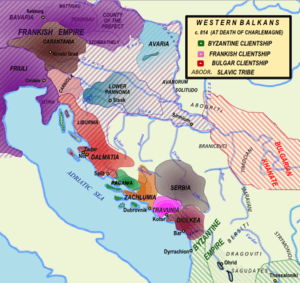Kanalites
Kanalites (Medieval Greek: Καναλῖται, Serbo-Croatian: Konavljani) were a medieval Slavic tribe settled in the Dalmatian subregion of Konavle, mentioned in the chapter titled "Of the Terbounians and Kanalites and of the country they now dwell in" of the 10th century De Administrando Imperio by Byzantine Emperor Constantine VII. The country, located in near proximity to Travunia, reportedly became desolated during the Pannonian Avars invasion, and its inhabitants are descendants from the unbaptized Serbs, from the time of the Unknown Archon who came from Boiki and claimed the protection of the Emperor Heraclius in the 7th century.[1] However, a closer reading suggests that the Constantine consideration about the population's ethnic identity, like in regard to other near polities, is based on Serbian political rule and also indicate ethnic origin.[1][2]

They were mentioned in the Vita Basilii among the Slavs who revolted during the time of Michael II and took part in the siege of Bari on the command of Basil I in 868. The archon of Kanali is recorded in the De Ceremoniis. They were an independent polity at least until 870. Although with Travunia made one political unit at the time of Constantine VII, only Travunia is mentioned under Serbian rule, and there's no mention of Kanali after the unification with Principality of Serbia.[1]
Etymology
Constantine VII in his DAI considered that Kanali "means in the language of the Slavs 'wagon-load', because, the place being level, they carry on all their labours by the use of wagons". Tibor Živković regarded such derivation wrong and rather considered Latin canalis and canabulae.[1]
See also
References
- Živković, Tibor (2012). De conversione Croatorum et Serborum: A Lost Source. Belgrade: The Institute of History. pp. 47, 160, 183–191, 192–195.CS1 maint: ref=harv (link)
- Budak, Neven (1994). Prva stoljeća Hrvatske (PDF). Zagreb: Hrvatska sveučilišna naklada. pp. 58–61. ISBN 953-169-032-4.
Glavnu poteškoću uočavanju etničke raznolikosti Slavena duž jadranske obale činilo je tumačenje Konstantina Porfirogeneta, po kojemu su Neretvani (Pagani), Zahumljani, Travunjani i Konavljani porijeklom Srbi. Pri tome je car dosljedno izostavljao Dukljane iz ove srpske zajednice naroda. Čini se, međutim, očitim da car ne želi govoriti ο stvarnoj etničkoj povezanosti, već da su mu pred očima politički odnosi u trenutku kada je pisao djelo, odnosno iz vremena kada su za nj prikupljani podaci u Dalmaciji. Opis se svakako odnosi na vrijeme kada je srpski knez Časlav proširio svoju vlast i na susjedne sklavinije, pored navedenih još i na Bosnu. Zajedno sa širenjem političke prevlasti, širilo se i etničko ime, što u potpunosti odgovara našim predodžbama ο podudarnosti etničkog i političkog nazivlja. Upravo zbog toga car ne ubraja Dukljane u Srbe, niti se srpsko ime u Duklji/Zeti udomaćilo prije 12. stoljeća. Povjesničari koji su bez imalo zadrške Dukljane pripisivali Srbima, pozivali su se na Konstantina, mada im on nije za takve teze davao baš nikakve argumente, navodeći Dukljane isključivo pod njihovim vlastitim etnonimom.